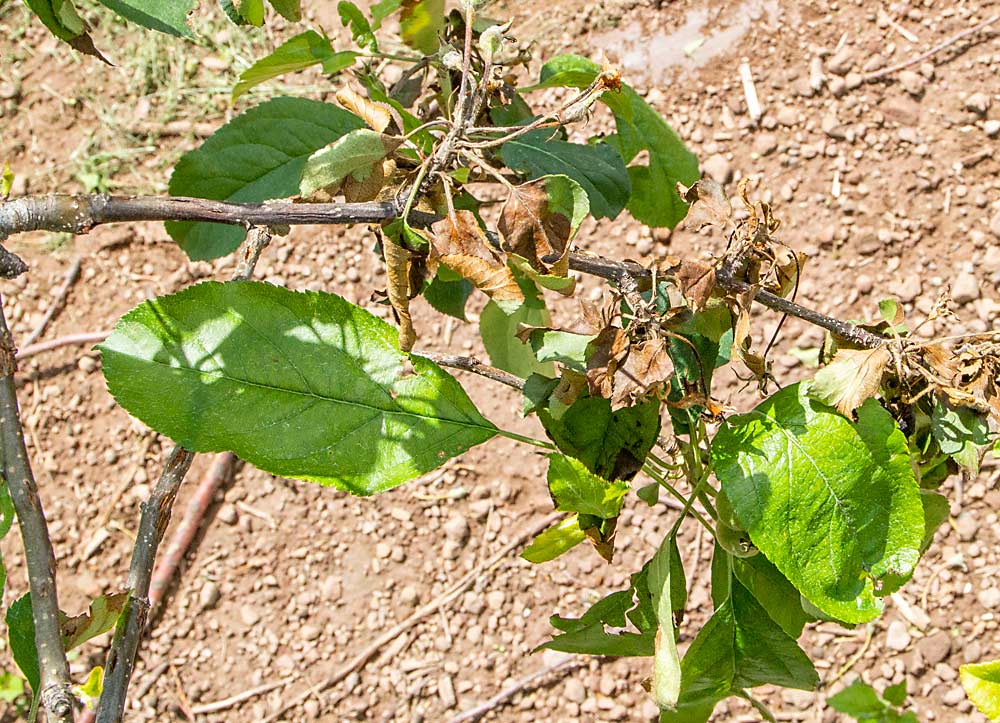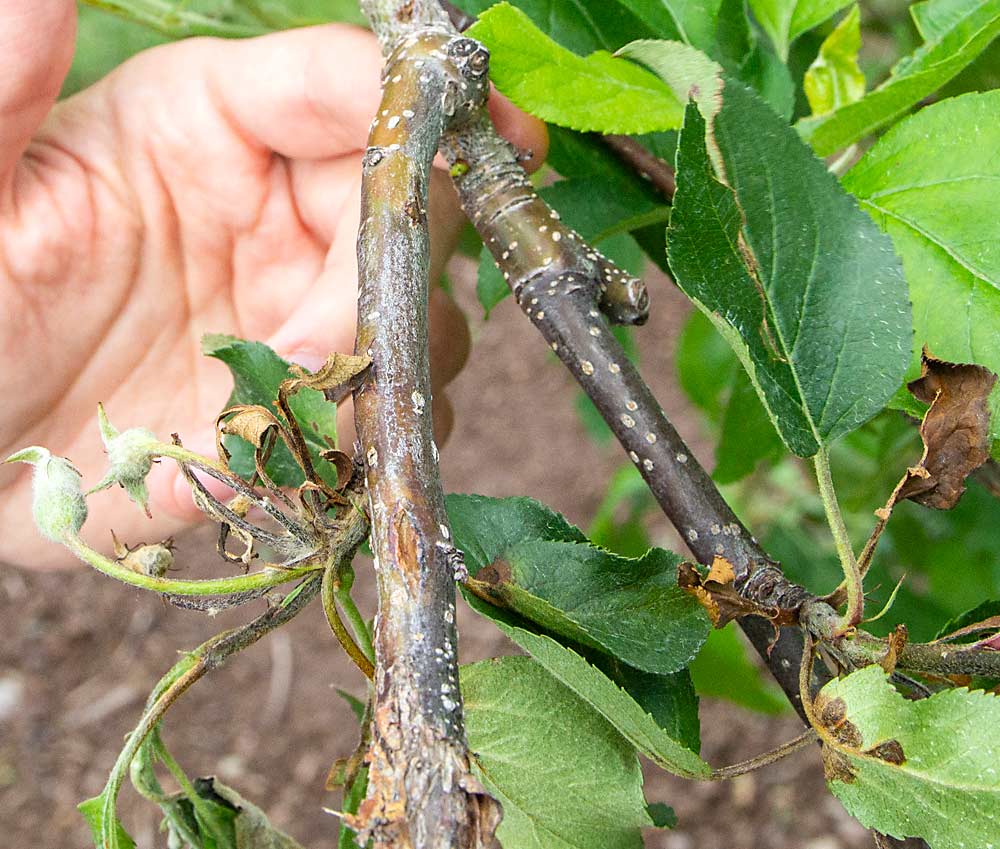
Shoot blight, as seen here in a pathology research block at Pennsylvania State University’s Fruit Research and Extension Center in Biglerville, Pennsylvania, is a constant threat to Eastern U.S. growers. However, growers also want to maximize the growth of young trees, so pathologists are exploring how to control fire blight without sacrificing growth. (Kate Prengaman/Good Fruit Grower)
One of the best tools for protecting young, high-density apple blocks from fire blight — prohexidione calcium — comes with a high cost: It stops the spread of shoot blight in the trees by stunting growth.
Given that trees are most at risk for blight in the early years when growers need to push growth and fill space, it can make them reluctant to use the product, better known as Apogee or Kudos, unless the threat is sufficiently high.
“Yes, you sacrifice a year of growth, but you still have your trees,” said Penn State University pathologist Kari Peter. “Last year, in 2018, that was a year you sacrificed growth.”
But if there is a way to avoid that catch-22, Peter and her counterpart at Cornell University, pathologist Kerik Cox, want to find it. At the Washington State Tree Fruit Association’s annual meeting in December in Yakima, Washington, they presented findings from recent and ongoing studies looking at alternate rates and timings of prohexidione calcium and alternative products that aim to turn on plants’ natural defenses.
“In Pennsylvania, we have significant fire blight challenges with our diverse growing systems,” Peter said. “We still have big old trees that get a lot of fire blight every year, but they are still productive. They are the Typhoid Marys in our fruit production system.”
The need to protect young, dwarf trees from those infectious neighbors and control shoot blight drives much of her research, she said. Cox agreed.
“An unnoticeable level of blossom blight can lead to devastating shoot blight growth,” Cox said. “However vigorous your trees are growing, that’s how vigorous the fire blight is growing.”
Adapting Apogee
Many growers have wondered if lower application rates of prohexidione calcium could help control shoot blight with less impact on growth. Both Cox and Peter have recently done such experiments and concluded that the impact on growth remains.
“As low as 2 ounces to the acre, we saw a 40- to 50-percent reduction in growth,” Peter said, but those low-dose programs still reduced disease severity.
Cox saw similar results, but said the frequent, lower-dose programs didn’t seem to offer any benefit in terms of disease control to recommend doing so over the standard program.
However, he had promising results to share from a trial applying Apogee during bloom.
“The idea being that if we stunt the growth around pink, we can stunt the blossom blight and give the tree the entire season to catch up,” he said. “Can we stop the blossom infection and stop the shoot blight before it starts?”
In a follow-up interview with Good Fruit Grower, Cox explained that since Apogee limits shoot growth instead of directly impacting the bacteria, it’s not commonly used at bloom. But when he heard that horticulturists were recommending applying it at pink for canopy management, that sparked an idea.
“Wait a minute, there is a little tiny shoot between the flower and the branch,” he said. “If the same thickening of the cell wall stopped the bacteria in that little pedicel, we can stop the progression from the flower into the cluster.”
Over three years of trials in a mature orchard, applying 6 ounces per 100 gallons at pink provided a good hurdle for blossom blight. He recommended following that with a biological product at bloom.
Last year, he tried the same thing in a 2-year-old Gala block and found the trees appeared to recover well from the temporary growth impacts and were comparable to the control trees by the end of the season.
“They are so vigorous they pushed right out of it by the time the fire blight threat was over,” Cox said. He plans to test the same trees over the next few seasons to assess cumulative growth impacts.
After he first presented this research last winter, growers began asking to try it, so Cox worked with state regulators to expedite an alternative use label for Apogee so that it could be used at pink in New York.
In a follow-up interview, Peter said she’s interested in trying it this season in Pennsylvania, as well. In the Northwest, researchers also hope to test the technique as part of a new fire blight control project seeking funding from the Washington Tree Fruit Research Commission.
Cox also found promising results from a trial to assess the risk of spreading shoot blight via mechanical blossom thinning and hedging. Previous research that suggested the practice is risky included unnaturally high inoculum levels and other departures from the way the practices are implemented commercially, so Cox decided to take another look at the risk.
He did the trials in an “incredibly dirty block,” running a string thinner from highly symptomatic trees to healthy ones beyond. He found that even in highly susceptible Idareds, the thinning didn’t spread blight much more than would have happened naturally under such high pressure, and following the thinning with streptomycin worked really well.
Similarly, with the sickle bar trial, Cox found that hedging followed by strep was better than his control. Hedging in August actually improved tree survival because it cut out shoot blight, he added.

A hailstorm in May 2018 caused extensive damage and likely increased shoot blight risk in an already high risk year, said Pennsylvania State University pathologist Kari Peter, showing symptoms and injury in her research block at the university’s Fruit Research and Extension Center in Biglerville. (Kate Prengaman/Good Fruit Grower)
Defenses on
In Pennsylvania, Peter’s recent work has focused on what she likes to call “plant defense elicitors.”
The best known, Actigard (acibenzolar-S-methyl), turns on tree defenses through a pathway called systemic acquired resistance, known as SAR for short. That’s led many to refer to all plant-defense-boosting products as SARs, but it’s important to note that the products actually target many different pathways, she said.
The benefit of these defense-eliciting products is that they don’t impact growth. The downside, especially for the biological products: Their performance is quite variable, Peter said.
In addition to synthetic Actigard, she looked at biologicals: Regalia (Reynoutria sachalinensis), Vacciplant (Laminarin), LifeGuard (Bacillus mycoides isolate) and Serenade (Bacillus subtilis) in recent trials with baby trees in the greenhouse and in established orchards.
Actigard works best on young trees, providing 80 to 100 percent control in the baby trees and 50 percent control on the 10-year-old trees. In a different trial, Peter found that it can still provide some control up to two weeks after application, but the best protection came with applications two and four days before infection.
“I know it’s so expensive, but if you have a new Aztec Fuji block or one of these new Gala strains that’s susceptible, you want to put it on those blocks and invest it where you are going to get your biggest payout,” she said.
As for the biologicals, Regalia also worked best on young trees, but provided just 20 percent control in the greenhouse and less in the mature orchards.
Vacciplant, on the other hand, seems to work better on older trees, Peter said, providing 8 percent control in the greenhouse trees and 28 percent control on the 10-year-old trees.
While Serenade is successful as a contact product to control blossom blight, she didn’t see it, or LifeGuard, trigger an immune response that could prevent shoot blight in the trees in her trials, Peter said. That may be different from what other researchers are finding in other regions, but local variables, such as climate or flower blossom microbiome, could be affecting performance of these biologicals.
Cox too, said he’s seen variable performance from the bio-based products, but Regalia performed well in his recent blossom blight trials.
“Maybe the formulations are getting better or I am just getting better at using them,” he mused.
“We don’t really know, outside of Actigard, how all these plant extract products, how they behave,” Peter said. “That’s why it’s taking us a really long time to understand the nuances of these bio-based products and how to use them.” •
—by Kate Prengaman
Related:
—Organic control options for fire blight
—Managing fire blight for the conventional grower
—Midwest faces strep-resistant fire blight
—Video: Fire blight management tips from the 2018 WSTFA Hort Show






Leave A Comment